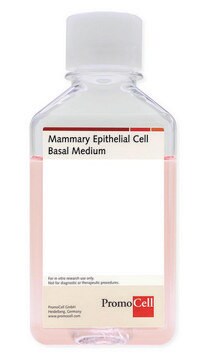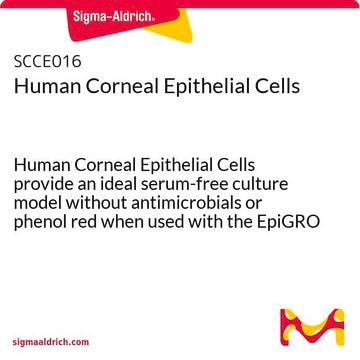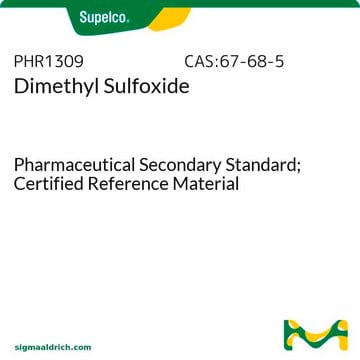830-05A
Human Mammary Epithelial Cells: HMEpC, adult
Synonyme(s) :
HMEpc cells
About This Item
Produits recommandés
Source biologique
human mammary glands (normal)
Niveau de qualité
Conditionnement
pkg of 500,000 cells
Fabricant/nom de marque
Cell Applications, Inc
Mode de croissance
Adherent
Caryotype
2n = 46
Morphologie
epithelial
Technique(s)
cell culture | mammalian: suitable
Maladie(s) pertinente(s)
cancer
Conditions d'expédition
liquid nitrogen
Température de stockage
−196°C
Description générale
Mammary Epithelial Cells provide an excellent model system to study many aspects of epithelial function and disease, particularly those related to cancerogenesis.
HMEpC have been utilized in numerous research publications, for example to:
- Investigate the role of exosomes secreted by cancer cells in formation of tumor permissive microenvironment through manipulation of normal mammary epithelium (Dutta, 2014)
- Serve as control in a study investigating antitumor properties of cannabinoids (Ligresti, 2006) and stem cell microenvironment (Rostovit, 2008)
- Determine that differential expression of glycoproteins allows to classify human breast cells into normal, benign, malignant, basal, and luminal groups (Yen, 2011, 2013; Timpe, 2013)
- Identify ALDH isoform 5A1 as a potential target for treatment of human breast ductal carcinoma (Kaur, 2012); and determine that combination of an anti-EGFR anti-VEGFR treatment using ZD6474 with phototherapy (UV-B) is more effective in treating breast cancer than either treatment alone (Sarkar, 2013)
- Demonstrate that although SIRT deacetylates p53, it does not play a role in cell survival following DNA damage (Solomon, 2006)
- Demonstrate the important roles of tumor suppressor Maspin by showing that it promotes mammary epithelial differentiation via its interaction with IRF6 (Bailey, 2008); mediates effects of IFN-γ on vacuolar pH, cathepsin D processing and autophagy, protects extracellular matrix (ECM) from degradation in normal mammary epithelia, and that Maspin loss in metastatic cancer leads to unrestricted ECM degradation, contributing to metastasis (Khalkhali-Ellis, 2007, 2008); and show that loss of EcSOD expression also promotes invasiveness by disrupting ECM (Teoh-Fitzgerald, 2012, 2013)
- Investigate the role of shortened telomeres in initiation of genomic instability, cytokinesis failure and polyploidy (Tusell, 2008; Soler, 2009; Pampalona, 2012); and elucidate the role of Myc in malignancy by studying its ability to transform primary epithelial cells (Thibodeaux, 2009)
- Demonstrate, along with Human dermal Fibroblasts, that resveratrol inhibits mono-ubiquitination of histone H2B (Gao, 2011)
HMEpC, along with Human Prostate Epithelial Cells, have also been used in a study demonstrating that TGF-b1 induces Smad 1/5/8 and Smad 2/3 phosphorylation and BMP signaling results only in Smad 1/5/8 phosphorylation in these primary epithelial cells, while in cancer cells BMP also elicits Smad2/3 activation, contributing to cancerogenesis (Holtzhausen, 2013).
Characterization: the cells have a characteristic morphology consistent with an epithelial origin and are positive for epithelial cell marker cytokeratin 18.
Origine de la lignée cellulaire
Application
Composants
Notes préparatoires
- 5th passage, >500,000 cells in Cell Basal Medium containing 10% FBS & 10% DMSO
- Can be cultured at least 16 doublings
Procédure de repiquage
Clause de non-responsabilité
Code de la classe de stockage
11 - Combustible Solids
Classe de danger pour l'eau (WGK)
WGK 3
Point d'éclair (°F)
Not applicable
Point d'éclair (°C)
Not applicable
Certificats d'analyse (COA)
Recherchez un Certificats d'analyse (COA) en saisissant le numéro de lot du produit. Les numéros de lot figurent sur l'étiquette du produit après les mots "Lot" ou "Batch".
Déjà en possession de ce produit ?
Retrouvez la documentation relative aux produits que vous avez récemment achetés dans la Bibliothèque de documents.
Les clients ont également consulté
Protocoles
Mammary Epithelial Cells and primary epithelial cells from other tissue at Cell Applications, your worldwide provider of human & animal cells, antibodies.
Notre équipe de scientifiques dispose d'une expérience dans tous les secteurs de la recherche, notamment en sciences de la vie, science des matériaux, synthèse chimique, chromatographie, analyse et dans de nombreux autres domaines..
Contacter notre Service technique










